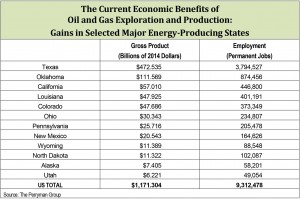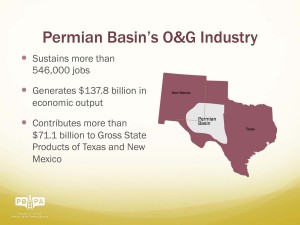“An industry once written off by some has roared back to life in recent years, contributing tremendous amounts to government coffers and creating some of the highest-paying jobs in Texas. Texas’ oil and gas businesses have brought together technology, manpower, and investment to keep the State number one in energy production despite turbulent times in energy markets. Under the threat of national and international economic and financial crises, Texas’ Oil and Gas Industry has been the fuel keeping the State fiscally and economically resilient.” Texas Oil and Gas Association
by Julie Anderson
Numbers Don’t Lie
One might think those in the oil and gas industry are still in disbelief. Is this too good to be true? When will the boom bubble burst? Perhaps this is why study after study has been commissioned and conducted, all with resoundingly similar results. What is the economic impact of the oil and gas industry? We’ll let the numbers tell the tale.
The Rainy Day flood: What the oil and gas comeback means for Texas
Thanks to a tremendous rebound in oil and gas drilling and production, the Texas Rainy Day Fund will be flush for years to come, according to a study released in late August 2014 by the Texas Taxpayers and Research Association (TTARA).
Under the Texas Constitution, 75 percent of all oil and gas severance tax revenue in excess of what the state collected in 1987 is to be deposited into the Economic Stabilization Fund, commonly referred to as the Rainy Day Fund. The Fund is capped at an amount equal to 10 percent of the state’s general revenue fund.
Texas collected $4.5 billion in severance taxes in 2013, setting an all-time record, as will the corresponding $2.5 billion deposit into the Rainy Day Fund.
Programs important to the economy and to Texas children have been funded by the Rainy Day Fund since its inception, according to the Office of the Texas Comptroller. As cited by the Texas Oil and Gas Association, these programs include:
- Public schools, student success and textbooks
- Teacher pay and teacher health insurance
- Medicaid
- Children’s Health Insurance Program
- Child Protective Services
- Foster care and adoption
- Criminal justice
- Emerging technology
- Texas Enterprise funding
- Disaster assistance
“To date, the new investment in oil and gas has generated over 300,000 new jobs in Texas, accounting for one-third of our recession recovery,” noted Dale Craymer, TTARA president. “Those trends will continue over the next several years because the investment is not being driven by price speculation but by cost-effective new technologies. Previously uneconomical plays in the Barnett and the Eagle Ford as well as around the Permian Basin are fueling new investment, new jobs, economic growth, and substantial growth in tax revenues.”
Rigzone “hot-off-the-press” figures:
Rigzone, a leading online resource for the oil and gas industry, released the following figures at press time:
- The oil and gas industry added 10,500 new jobs over the second quarter, representing a two-thirds increase over the same period in 2013.
- Between April and June, companies in the oil and gas sector added more than 4,000 new positions in Texas.
“In total, looking at the first half of the year, over 20,000 positions in the United States were created,” reported Paul Caplan, president of Rigzone. “Last year at this time, the halfway mark of the year was about 12,600, so we’re talking about a substantial increase in the number of, especially, production jobs.”
Economic Benefits
It’s a hefty title for a hefty report. They’re calling it “The Economic Benefits of Oil and Natural Gas Production: An Analysis of Effects on the United States and Major Energy-Producing States.”
The total economic benefits of oil and gas exploration and development activity (including multiplier effects) are estimated to include almost $1.2 trillion in gross product each year, as well as more than 9.3 million permanent jobs in the United States, as detailed in this report released in late August 2014 by The Perryman Group.
“When you include the ripple effects through the economy, oil and natural gas exploration and production supports nearly seven percent of the U.S. economy,” detailed Dr. Ray Perryman, president and CEO of The Perryman Group.
The resurgence of the oil industry over the past few years has been dramatic, the report states. Production levels have reached totals not seen since the late 1980s, and they continue to increase. In 2012, total U.S. production was almost 2.4 billion barrels, with 2013 rising to more than 2.7 billion. Although the United States still relies on imports to meet about 40 percent of crude oil needs, the increase in domestic supplies has helped reduce dependency on foreign oil and improve the U.S. trade situation.
The full report is available at perrymangroup.com/wp-content/uploads/Perryman-Oil-Impact-Study.pdf.
“While changing market conditions will lead to cycles in the industry,” Dr. Perryman surmised, “the oil and gas industry will be a driver of substantial economic activity for many years to come.”
Current and Future Economic Impacts of the Texas Oil and Gas Pipeline Industry
The Texas Pipeline Association commissioned a study released in July 2014 by the Jerry S. Rawls College of Business and Bob L. Herd Department of Petroleum Engineering at Texas Tech University, which yielded the following:
In the year 2013, the total economic impact from Texas pipeline operations and construction included:
- Over $33 billion in economic output
- More than 165,000 jobs
- Over $18.7 billion in additional gross state product
- Over $1.6 billion in state and local government revenues
By the year 2024, depending on economic conditions, projections demonstrate that the total economic impact from Texas pipeline operations and construction will generate:
- $30 billion – 41.4 billion in economic output (in today’s dollars)
- 150,000 – 206,000 jobs
- $17 billion – 23.4 billion in additional gross state product (in today’s dollars)
- $1.5 billion – $2 billion in state and local government revenues (in today’s dollars)
Between the current year and 2024, the Texas pipeline industry will generate cumulative economic impacts (in today’s dollars) of around $374 billion in economic output, $212 billion in additional gross state product, and contribute $19.5 billion in state and local government revenues. Additionally, the industry will sustain an average of around 171,000 jobs per year in the State of Texas.
Economic Impact of Oil and Gas Activities in the West Texas Energy Consortium Region
This report was prepared by the Center for Community and Business Research at The University of Texas at San Antonio’s Institute for Economic Development, with Thomas Tunstall, Ph.D., as the principal investigator and Javier Oyakawa, M.A., MSc., as the lead investigator. The project was supported with funding from the West Texas Energy Consortium and released in December 2013. The study was conducted to estimate the economic impacts of the oil and gas industry on 10 counties in the consortium in 2012 and to create a forecast for the year 2022. The ten counties included Fisher, Glasscock, Howard, Irion, Martin, Mitchell, Nolan, Reagan, Scurry, and Sterling. The study also examined the indirect economic impacts of oil and gas activity from the 10-county area into neighboring Brown, Coke, Coleman, Runnels, Taylor and Tom Green counties.
Projected Impacts for 2022:
- The total impact of oil and gas industry activity in the ten counties in 2022 is forecasted to be more than $20 billion in the moderate scenario, with 30,540 jobs anticipated, and revenues of $664 million for local governments and $701 million for state government.
- Oil and gas activity in plays such as the Cline shale and Wolfberry plays will generate $701 million in state revenues in 2022, including $334 million in severance taxes, creating close to $9.4 billion in gross regional product and contributing approximately $664 million in local government revenues.
- The number of full-time jobs supported by the oil and gas industry in 2022 compared with 2012 represents a 42.2 percent increase, a rate of growth that almost doubles the estimated 21.7 percent growth in total employment in the area for the same period.
Economic Impact Permian Basin’s Oil and Gas Industry
The following figures covering 2013 were presented by Ben Shepperd, president of the Permian Basin Petroleum Association, at the June 2014 LEDA Drilling Down Conference. The Permian Basin industry:
- Generates $137.8 billion in economic output
- Contributes more than $71.1 billion to the gross state products of Texas and New Mexico
- Sustains 546,000 jobs in the Permian Basin including
* 130,000 Support
* 87,000 Extraction
* 36,000 Drilling
* 31,000 Maintenance
* 26,000 Food Service
* 17,000 Architecture & Engineering
* 11,000 Wholesale Trade
* 8,700 Financial Services
* 8,600 Civic, Social Organization
* 190,700 other job sectors
- Economic Multipliers: $1.5 billion from gas and $2.1 billion from oil paid in taxes, through property, sales and use, franchise, and local taxes.
Julie Anderson, based in Odessa, is editor of County Progress magazine and is well known to many readers of PBOG as the former editor of this magazine.











